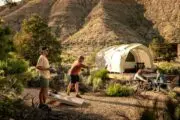At first glance, the beginnings of Howard Park in Toronto’s Roncesvalles Village neighbourhood look like your average construction site: large bulldozers shovel dirt as construction workers lay steel rebar and swelter in the sunlight. But it’s the clusters of tiny pipes, protruding from the ground and spray painted in bright neon hues, that make the site distinct. They’re a stark contrast to the surrounding building materials, as if calling out for attention.
The colourful pipes mark the start of a geothermal system that will collect renewable energy from the earth to heat and cool the eight-storey residential building, instead of burning fuel and emitting harmful greenhouse gases. The pipes are inserted four to six feet below ground, where the temperature of the soil remains constant year round. Howard Park is one of few residential buildings in Toronto to implement this system, but the concept is picking up steam throughout the country.
“Buildings are making such a huge contribution to carbon dioxide emissions and waste that it’s our duty to design responsibly,” said Jon Jeronimus, a project architect at RAW Design, the firm tasked with designing Howard Park. “We need to optimize the efficiency of a building and reduce energy consumption. It should be a given at this stage.”
Howard Park follows Tier 2 of the Toronto Green Standards (TGS), a set of energy performance measures geared toward new residential and non-residential buildings to help encourage sustainable development. As of January 31st 2010, new construction buildings throughout the city are required to meet Tier 1 standards, while the second level is voluntary.
Buildings must demonstrate a 25 per cent improvement over the Ontario Building Code to be eligible for Tier 2, and according to Jeronimus, a geothermal system alone practically gets you there. Applicants that meet the higher standard are also refunded 20 per cent of the City’s development charge.
“It’s an incentive [for builders] to increase energy efficiency,” he said.
Over the last decade, developers in Canada have become more receptive to the idea of building green, to the point where cities identified as concrete jungles are attempting to mimic an actual forestland, with earth-friendly features sprouting up almost as often as the buildings themselves. While the shift in thinking is undoubtedly a good thing, it also becomes more challenging for people to distinguish the truly green buildings from those that merely boast the title — the fake plants posing as the real thing, so to speak.
“If gas and oil prices continue to rise so significantly, people won’t be able to live in their house anymore. It will end up costing them $500 to $600 a month just to heat it.”
The internationally-recognized LEED rating system, for example, is both commended and condemned by developers and residents alike. After the program was established in March 2000 by the U.S. Green Building Council (and later introduced in Canada in 2003) many have argued that the program’s points system is far too gimmicky. There’s even an article featured on the Green Builder Advisor that outlines, step by step, “how to cheat at LEED for homes.”
Brian Persaud, a Toronto-based real estate agent, author and host of HGTV’s Income Property, is no stranger to the criticism.
“The people I know who are really environmentally conscious don’t really like LEED,” he said. “They feel it’s political. You install some bike racks and you get points — a lot of people aren’t happy with that.”
Persaud notes that LEED makes more sense for commercial developments, where the tenants manage the operating costs. On the residential end, when the price tag tends to be top of mind for purchasers, he doesn’t see the market buying into it — at least not yet.
“Sustainable high-rise buildings introduce a higher cost to build and developers charge a premium for it,” he said. “So the price per square foot becomes quite high and people are forced to rent them out. Tenants won’t pay more of a premium on a LEED building.”
LEED-certified or not, the price tags attached to many of these sustainable developments don’t always sit well with the average house hunter. For an extreme example, just look to the newest season of Million Dollar Listing New York, an American reality show, where broker Fredrik Eklund is determined to sell an over-the-top eco-friendly penthouse in north-east Tribeca. Though the 3,381-square-foot residence boasts solar panels, UV-coated windows, Sub-Zero appliances, solar-powered hot water, three terraces and even a 900-square-foot deck, the common charges total a whopping $9,000 a month. After being on and off the market for more than five years, the four-floor penthouse finally sold for $5.35 million, down from its original listing price of $9.175 million.
Geothermal pipes at the Howard Park construction site in Roncesvalles. Photo: James Bombales
But despite the criticism, other industry experts believe the LEED system itself is a step in the right direction. Jonathan Westeinde, co-founder of The Windmill Development Group, partially agrees with Persaud, but still praises the program’s potential.
“Certainly to get certified there are a number of points that you could buy technically, but you still need to go through 80 or 90 per cent of the rigour,” he said. “It is a criticism, but I still think it’s a progressive thing that’s happening.”
More than 1,600 LEED-certified buildings now exist throughout Canada and nearly 3,000 more are registered to be granted status. And the numbers are only increasing: 573 projects became LEED-certified in Canada in 2013, compared to 346 certified in 2012 and 190 in 2011.
With more buildings — residential or otherwise — parading their certification, Westeinde says one downside is that it becomes more challenging to ensure a developer is following through on its energy-saving promises. Whereas every Windmill project is LEED Platinum certified, making it one of country’s greenest development companies, he says it’s important for purchasers to be aware of the distinction.
“Increasingly more people are advertising green features, so that’s why we focus on actually getting the final certification…so we can demonstrate that we did what we said we were going to do,” he said. “Where in a lot of cases, there’s a lot of marketing, but it’s hard for people to verify what was actually done.”
For this reason, Windmill Developments is moving toward a One Planet Living (OPL) framework in conjunction with LEED. The global initiative, developed by World Wildlife Fund (WWF) and BioRegional, is shaped around 10 principles of sustainability — from zero carbon to health and happiness and even sustainable food.
The initiative’s premise: how to best utilize the world’s resources so that everyone can live and thrive on one planet. If everyone in the world lived like the average North American, according to WWF, we’d need five planets to support us.
There are currently seven OPL-endorsed communities across the globe – including two in the U.S. and others in Australia, Portugal and the UK. Windmill will be the first developer to introduce an OPL building in Canada with its sustainable mixed-use community in downtown Ottawa-Gatineau called The Isles.
“We see the program as something that will become more universally accepted on a residential side, just for how it’s broken down and marketable,” Westeinde said. “It goes beyond what you’re doing with your building and is more about how it’s being built.”
Another one of the most widely-recognized green building guides is ENERGY STAR, a brand that labels and identifies energy-efficient products (these sustainable appliances also count towards a developments’ LEED certification). A home or entire development can also be ENERGY STAR certified, which requires a building to be at least 20 per cent more efficient than a project built to Canada’s energy code.
There’s also R-2000, another certification standard for new construction homes developed by Natural Resources Canada (NRC) that’s existed for more than 30 years. The voluntary standard requires even higher levels of energy efficiency than ENERGY STAR and places more emphasis on clean air and environmental features, such as high-efficiency heating.

Whether ENERGY STAR approved or R-2000 certified, sales of new energy-efficient homes number close to $4.8 billion annually, according to NRC. On the flip side, these homes provide $110 million annually in energy savings for Canadian homeowners.
With all the varying alternatives in mind, the concept of constructing a green home becomes somewhat convoluted. But the question remains: how is a purchaser to separate the genuinely sustainable residential developments from the overly-hyped and heavily marketed buildings that may not live up to their green label?
Howard Park, with its geothermal system, green roof and locally-sourced finishes, is just one example of a bona fide sustainable project. Jon Jeronimus is also an advocate of Passive House (or Passivhaus), which was first established in Germany. Homes built to this standard reduce energy consumption by 80 to 90 per cent through proper insulation, zero air leakage, durable windows with triple-pane glass and an orientation that allows the sun to heat the building in the winter and provide shade during summer months. In other words, it’s comparable to heating a house with a hair dryer, Jeronimus said.
While ultra-low energy buildings such as these are few and far between in Toronto, Persaud says he can see the concept appearing on residents’ radars down the road.
“If gas and oil prices continue to rise so significantly, people won’t be able to live in their house anymore, because it will end up costing them $500 to $600 a month just to heat it,” he said. “So people are going to say, ‘well it costs me this much money to just carry my house, I want to buy a [sustainable] condo unit where the operating costs are a lot less’.”
But for the truly sustainable buildings to flourish throughout the country in the years to come, Jeronimus says it’s about more than just cost. It’s also about transparency.
“We have to get more comprehensive in our understanding of buildings and building systems,” he said. “Communication will become so key, because there are going to be more consultants involved. We just need to get smarter. It’s more of a challenge but it’s where we need to go.”
We interviewed Jon Jeronimus from RAW Design about energy-saving strategies and the importance of building green.








